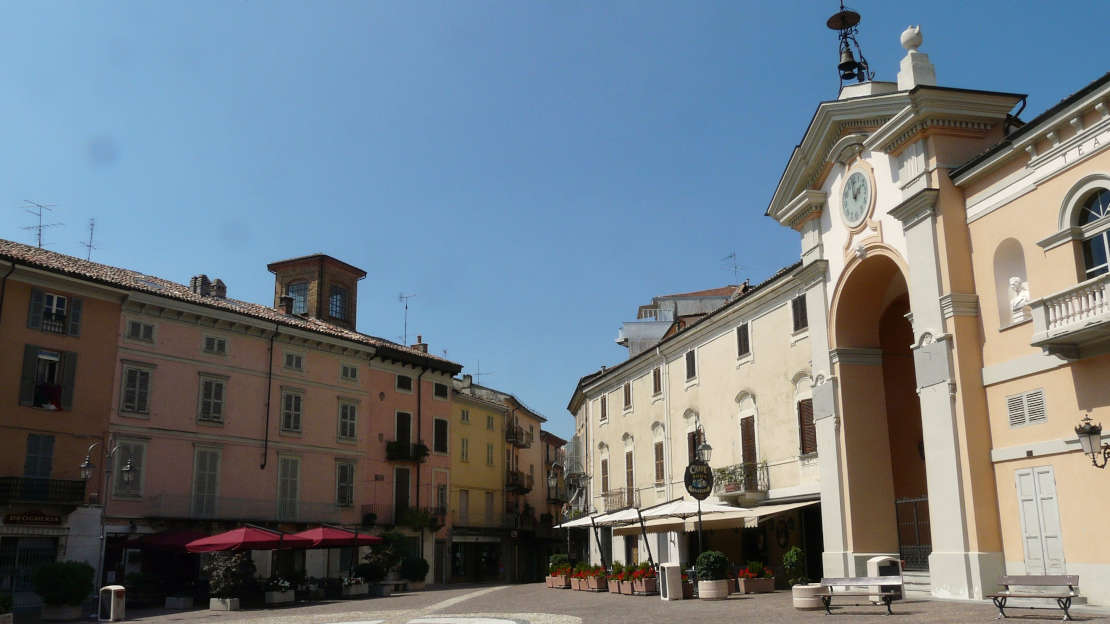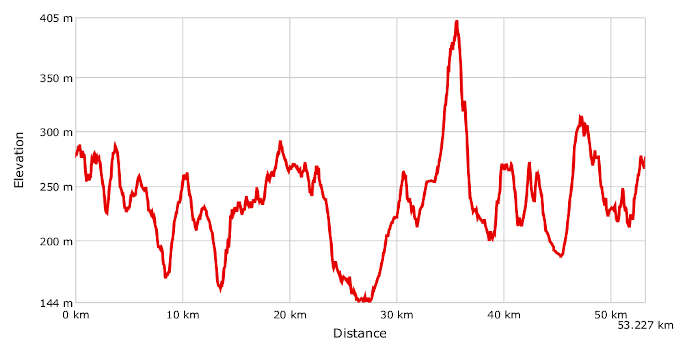
- Bike: mtb
- Difficulty: ***
- Distance: 63 km
- Altitude difference: 251 m
- Total ascent: 1170 m
- Total descent: 1173 m

Aleramo, founder of the dynasty of the Marquises of Monferrato, was born in Sezzadio in 904 and died in Grazzano Badoglio in 991, and his tomb remains to this day in the church of Santi Vittore e Corona. There is scant biographical information on Aleramo. Son of William I, from the lands of Burgundy in France, Aleramo is named for the first time in documents when he received a fief near Vercelli from Hugh I, King of Italy, in 933. In 955 he was invested with some lands in what is now the Province of Alessandria and Asti, including Grazzano Abbey, which Aleramo had built between 950 and 960 on top of a hill where the ancient Roman fort was presumably once situated. Aleramo was named Marquess through the intercession of his wife Gerberga, daughter of King Berengar II.
Shortly afterwards, however, Aleramo abandoned his wife Gerberga and King Berengar II, siding with Otto I, Holy Roman Emperor. After an episode of war in which Aleramo saved the life of the Emperor himself, Otto I granted sixteen courts in the ‘lands existing from the river Tanaro to the river Orba and to the shore of the sea’, the initial core of the burgeoning March. With this, we make reference to the heroic horse ride of Aleramo, a feat which was to determine the land border of Monferrato. After Italy came under the direct control of the Holy Roman Empire in 962, Aleramo was granted the titles of German-Roman Emperor by Otto I on 21 March 967. Following an elopement between Aleramo and Otto’s daughter Alasia, he consented to their marriage despite his anger at the flight of the two lovers.
Presumably, Marquess Aleramo died prior to 991 and was briefly succeeded by his son Otto I, who was succeeded in his turn by his son William III. Unaided by documentary evidence, tradition has it that Aleramo was buried in Grazzano Abbey, which he had founded in what is now the village of Grazzano Badoglio (formerly Grazzano Monferrato). What remains of the historic abbey today are the Romanesque belfry, the portico of the old presbytery with balcony, the cloister and the octagonal apse. It has acted as parish church since 1566, the building extended and consecrated in 1580 as the Church of Santi Vittore e Corona. Aleramo’s presumed remains were transferred inside the church on that occasion. The tomb was adorned with a mosaic that can be linked to the first third of the 12th century and a portrait of Aleramo by Guglielmo Caccia, who was known as the Moncalvo.
The route starts from Grazzano Badoglio in Piazza Giuseppe Giacomo Cotti, the square where tamburello is played and where you’ll find parking. A visit to the church of Santi Vittore e Corona is a must. You enter it from Via Aleramo. After the visit, set off again along Via Mameli. Continuing, keep left until it becomes a dirt road that extends, among expanses of vineyard, to the village of Casorzo. The dirt road most travelled by local bikers leads from here to Montemagno, amid breathtaking views. It can be recognised thanks to its fairy-tale castle. After going round the castle walls and visiting the church of Santi Martino e Stefano, continue out through the village lanes down dirt roads into the valley leading to Castagnole Monferrato. The SP 92 and SP 38 lead, via attractive tarmac roads featuring great views, to San Desiderio then Calliano. After a quick visit to the village that hosts the Palio degli Asini (donkey race), continue on Strada Serra. At the junction outside the village, keep right on the dirt country road until you’re near the hamlet of Perrona. Come down on the SP 52 here, turning right, and after 400 m turn left back onto the dirt road. After about 3 km, come back onto tarmac in the village of Tonco. You have to stop here to catch your breath, since the following stretch involves a steep climb. Pass the hamlet of Casa Paletti then Cardona, a hamlet in Alfiano Natta. The climb starts here, extending among woods to the highest point on the route, at a height of 405 m in the Colli Pietrosi hills, where the abandoned little church of Santo Spirito is to be found. After getting to the top, head down via some ups and downs to reach the outskirts of Odalengo Piccolo in Guazzolo. This hamlet is home to Elso Gabiano, professional cyclist and member of Learco Guerra's team Guerra Ursus in 1953-54. Learco Guerra won the legendary 1931 World Championship in Copenhagen.
Come down from the village then climb up again to Castelleto Merli. Coming down again from the village, you arrive at the Moncalvo railway station. From here, go up to the town centre. Continue to conclude the route, coming out of the town on Via Monsignore Bolla, on the road that passes the cemetery. When you get to the SP 30, turn left in the direction of Grazzano Badoglio. After 600 m, come off the tarmac road to head down on the right among fields and vineyards. Afterwards, climb Strada Luigi Einaudi, which leads to Grazzano Badoglio.
The route takes you to the municipalities that launched a marketing initiative for promoting the local wines entitled Nelle Terre di Aleramo (in the land of Aleramo). This area has a special calling for producing red wines and some of the best are Barbera d’Asti, Grignolino, Ruchè di Castagnole Monferrato and Malvasia di Casorzo.
